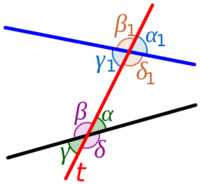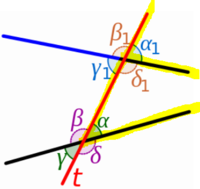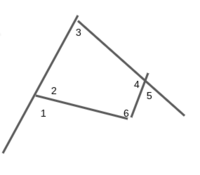You are using an out of date browser. It may not display this or other websites correctly.
You should upgrade or use an alternative browser.
You should upgrade or use an alternative browser.
name an angle (gr8)
- Thread starter ale434
- Start date
Dr.Peterson
Elite Member
- Joined
- Nov 12, 2017
- Messages
- 16,870
The first two and the last are odd; normally they refer to a transversal of a pair of parallel lines, or at least of two lines that are the focus of attention. I see two angles that might be thought of as corresponding to angle 3, and one that you might think of as an alternating interior angle with angle 1, in each case depending on which line you think of as if it were a transversal. For example, if you think of the line from 2 to 6 as a transversal of the lines joining 1 and 3, and 4 and 6, how are angles 1 and 6 related?
The fact that some lines aren't drawn so that they actually intersect is particularly odd. Is this the original picture, or did you try to copy it and mess it up?
The two "supplementary" questions are easy. Try them first.
The fact that some lines aren't drawn so that they actually intersect is particularly odd. Is this the original picture, or did you try to copy it and mess it up?
The two "supplementary" questions are easy. Try them first.
pka
Elite Member
- Joined
- Jan 29, 2005
- Messages
- 11,978
I am sorry to tell you but who ever set this question had no idea of the terms involed.View attachment 27537NAME THE ANGLES:
alternate interior to <1
corresponding to < 3
supplementary to < 1
supplementary to < 5
interior on the same side of the transversal to < 3
Please look at this link. If you do you will see the there is no actual transversal in the diagram you were given.
On that page it is written "In geometry, a transversal is a line that passes through two lines in the same plane at two distinct points. Transversals play a role in establishing whether two or more other lines in the Euclidean plane are parallel. The intersections of a transversal with two lines create various types of pairs of angles: consecutive interior angles, consecutive exterior angles, corresponding angles, and alternate angles. "
Please read the whole link then post your questions.
Harry_the_cat
Elite Member
- Joined
- Mar 16, 2016
- Messages
- 3,779
It might help to remember:
1. Alternate angles form a Z shape. Can you trace a Z shape with your finger starting at the bottom left of you diagram, including angle 1 and another angle? Give it a go.
2. Corresponding angles form an F shape (or a backwards F shape) with both under the arms of the F. Can you see an F shape (or a backwards F shape) where angle 3 is under one arm. What angle is under the other? Note: there are actually 2 possible answers here.
Show me your answers to these two and I will then help with the others.
1. Alternate angles form a Z shape. Can you trace a Z shape with your finger starting at the bottom left of you diagram, including angle 1 and another angle? Give it a go.
2. Corresponding angles form an F shape (or a backwards F shape) with both under the arms of the F. Can you see an F shape (or a backwards F shape) where angle 3 is under one arm. What angle is under the other? Note: there are actually 2 possible answers here.
Show me your answers to these two and I will then help with the others.
Harry_the_cat
Elite Member
- Joined
- Mar 16, 2016
- Messages
- 3,779
I think it is just a badly drawn diagram, possibly redrawn by the poster.I am sorry to tell you but who ever set this question had no idea of the terms involed.
Please look at this link. If you do you will see the there is no actual transversal in the diagram you were given.
On that page it is written "In geometry, a transversal is a line that passes through two lines in the same plane at two distinct points. Transversals play a role in establishing whether two or more other lines in the Euclidean plane are parallel. The intersections of a transversal with two lines create various types of pairs of angles: consecutive interior angles, consecutive exterior angles, corresponding angles, and alternate angles. "
Please read the whole link then post your questions.
pka
Elite Member
- Joined
- Jan 29, 2005
- Messages
- 11,978
Having taught axiomatic geometry for graduates, I am very sensitive to vocabulary. Wylie in his text The Foundations of Geometry uses this definition: A transversal of two coplanar lines is a line which intersect the union of the lines in two points.
There are alternate exterior angles.

In the diagram above \(\alpha_1~\&~\gamma\) are alternate exterior angles while \(\delta_1~\&~\beta\) are alternate interior angles.
We are hard pressed to find an \(F\) in that.
Note that the two lines are parallel. Thus your \(Z\) only holds for parallel lines and alternate interior angles.1. Alternate angles form a Z shape.
There are alternate exterior angles.

In the diagram above \(\alpha_1~\&~\gamma\) are alternate exterior angles while \(\delta_1~\&~\beta\) are alternate interior angles.
But \(\alpha~\&~\alpha_1\) are corresponding angles as are \(\beta~\&~\beta_1\).2. Corresponding angles form an F shape (or a backwards F shape) with both under the arms of the F.
We are hard pressed to find an \(F\) in that.
Dr.Peterson
Elite Member
- Joined
- Nov 12, 2017
- Messages
- 16,870
Here is the F for the alphas:Having taught axiomatic geometry for graduates, I am very sensitive to vocabulary. Wylie in his text The Foundations of Geometry uses this definition: A transversal of two coplanar lines is a line which intersect the union of the lines in two points.
Note that the two lines are parallel. Thus your \(Z\) only holds for parallel lines and alternate interior angles.
There are alternate exterior angles.
View attachment 27546
In the diagram above \(\alpha_1~\&~\gamma\) are alternate exterior angles while \(\delta_1~\&~\beta\) are alternate interior angles.
But \(\alpha~\&~\alpha_1\) are corresponding angles as are \(\beta~\&~\beta_1\).
We are hard pressed to find an \(F\) in that.

This is a reasonable way to tell young students what corresponding angles mean, though of course there are more sophisticated ways to say it at college level.
The Z idea of course refers only to alternate interior angles, which is what the question refers to. And all of this, for non-parallel lines, represents a sort of "topological" view, ignoring parallelism and focusing on general relationships.
And, of course, your "parallel" lines are not; I'm not sure if there is a specific term that can be used other than "a pair of lines".
Harry_the_cat
Elite Member
- Joined
- Mar 16, 2016
- Messages
- 3,779
Pka, you say "Thus your Z only holds for parallel lines". I disagree.
Only if the lines are parallel are the alternate angles congruent. But they are still termed alternate angles even if the lines are not parallel. They form a Z "shape" even if the lines are not parallel.
Only if the lines are parallel are the alternate angles congruent. But they are still termed alternate angles even if the lines are not parallel. They form a Z "shape" even if the lines are not parallel.

